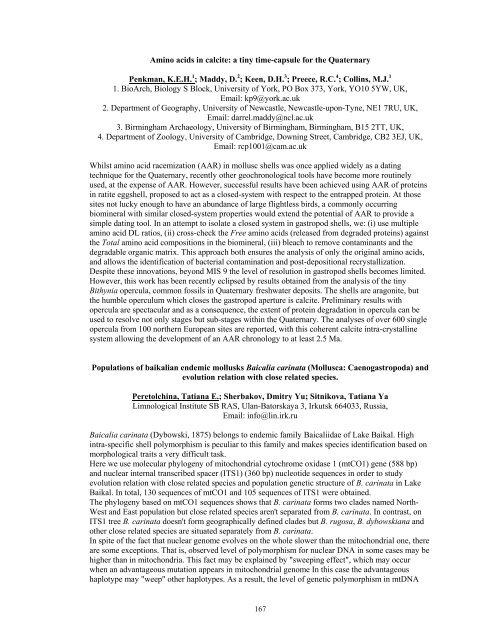World Congress of Malacology Antwerp ... - Unitas Malacologica
World Congress of Malacology Antwerp ... - Unitas Malacologica
World Congress of Malacology Antwerp ... - Unitas Malacologica
Create successful ePaper yourself
Turn your PDF publications into a flip-book with our unique Google optimized e-Paper software.
Amino acids in calcite: a tiny time-capsule for the Quaternary<br />
Penkman, K.E.H. 1 ; Maddy, D. 2 ; Keen, D.H. 3 ; Preece, R.C. 4 ; Collins, M.J. 1<br />
1. BioArch, Biology S Block, University <strong>of</strong> York, PO Box 373, York, YO10 5YW, UK,<br />
Email: kp9@york.ac.uk<br />
2. Department <strong>of</strong> Geography, University <strong>of</strong> Newcastle, Newcastle-upon-Tyne, NE1 7RU, UK,<br />
Email: darrel.maddy@ncl.ac.uk<br />
3. Birmingham Archaeology, University <strong>of</strong> Birmingham, Birmingham, B15 2TT, UK,<br />
4. Department <strong>of</strong> Zoology, University <strong>of</strong> Cambridge, Downing Street, Cambridge, CB2 3EJ, UK,<br />
Email: rcp1001@cam.ac.uk<br />
Whilst amino acid racemization (AAR) in mollusc shells was once applied widely as a dating<br />
technique for the Quaternary, recently other geochronological tools have become more routinely<br />
used, at the expense <strong>of</strong> AAR. However, successful results have been achieved using AAR <strong>of</strong> proteins<br />
in ratite eggshell, proposed to act as a closed-system with respect to the entrapped protein. At those<br />
sites not lucky enough to have an abundance <strong>of</strong> large flightless birds, a commonly occurring<br />
biomineral with similar closed-system properties would extend the potential <strong>of</strong> AAR to provide a<br />
simple dating tool. In an attempt to isolate a closed system in gastropod shells, we: (i) use multiple<br />
amino acid DL ratios, (ii) cross-check the Free amino acids (released from degraded proteins) against<br />
the Total amino acid compositions in the biomineral, (iii) bleach to remove contaminants and the<br />
degradable organic matrix. This approach both ensures the analysis <strong>of</strong> only the original amino acids,<br />
and allows the identification <strong>of</strong> bacterial contamination and post-depositional recrystallization.<br />
Despite these innovations, beyond MIS 9 the level <strong>of</strong> resolution in gastropod shells becomes limited.<br />
However, this work has been recently eclipsed by results obtained from the analysis <strong>of</strong> the tiny<br />
Bithynia opercula, common fossils in Quaternary freshwater deposits. The shells are aragonite, but<br />
the humble operculum which closes the gastropod aperture is calcite. Preliminary results with<br />
opercula are spectacular and as a consequence, the extent <strong>of</strong> protein degradation in opercula can be<br />
used to resolve not only stages but sub-stages within the Quaternary. The analyses <strong>of</strong> over 600 single<br />
opercula from 100 northern European sites are reported, with this coherent calcite intra-crystalline<br />
system allowing the development <strong>of</strong> an AAR chronology to at least 2.5 Ma.<br />
Populations <strong>of</strong> baikalian endemic mollusks Baicalia carinata (Mollusca: Caenogastropoda) and<br />
evolution relation with close related species.<br />
Peretolchina, Tatiana E.; Sherbakov, Dmitry Yu; Sitnikova, Tatiana Ya<br />
Limnological Institute SB RAS, Ulan-Batorskaya 3, Irkutsk 664033, Russia,<br />
Email: info@lin.irk.ru<br />
Baicalia carinata (Dybowski, 1875) belongs to endemic family Baicaliidae <strong>of</strong> Lake Baikal. High<br />
intra-specific shell polymorphism is peculiar to this family and makes species identification based on<br />
morphological traits a very difficult task.<br />
Here we use molecular phylogeny <strong>of</strong> mitochondrial cytochrome oxidase 1 (mtCO1) gene (588 bp)<br />
and nuclear internal transcribed spacer (ITS1) (360 bp) nucleotide sequences in order to study<br />
evolution relation with close related species and population genetic structure <strong>of</strong> B. carinata in Lake<br />
Baikal. In total, 130 sequences <strong>of</strong> mtCO1 and 105 sequences <strong>of</strong> ITS1 were obtained.<br />
The phylogeny based on mtCO1 sequences shows that B. carinata forms two clades named North-<br />
West and East population but close related species aren't separated from B. carinata. In contrast, on<br />
ITS1 tree B. carinata doesn't form geographically defined clades but B. rugosa, B. dybowskiana and<br />
other close related species are situated separately from B. carinata.<br />
In spite <strong>of</strong> the fact that nuclear genome evolves on the whole slower than the mitochondrial one, there<br />
are some exceptions. That is, observed level <strong>of</strong> polymorphism for nuclear DNA in some cases may be<br />
higher than in mitochondria. This fact may be explained by "sweeping effect", which may occur<br />
when an advantageous mutation appears in mitochondrial genome In this case the advantageous<br />
haplotype may "weep" other haplotypes. As a result, the level <strong>of</strong> genetic polymorphism in mtDNA<br />
167



